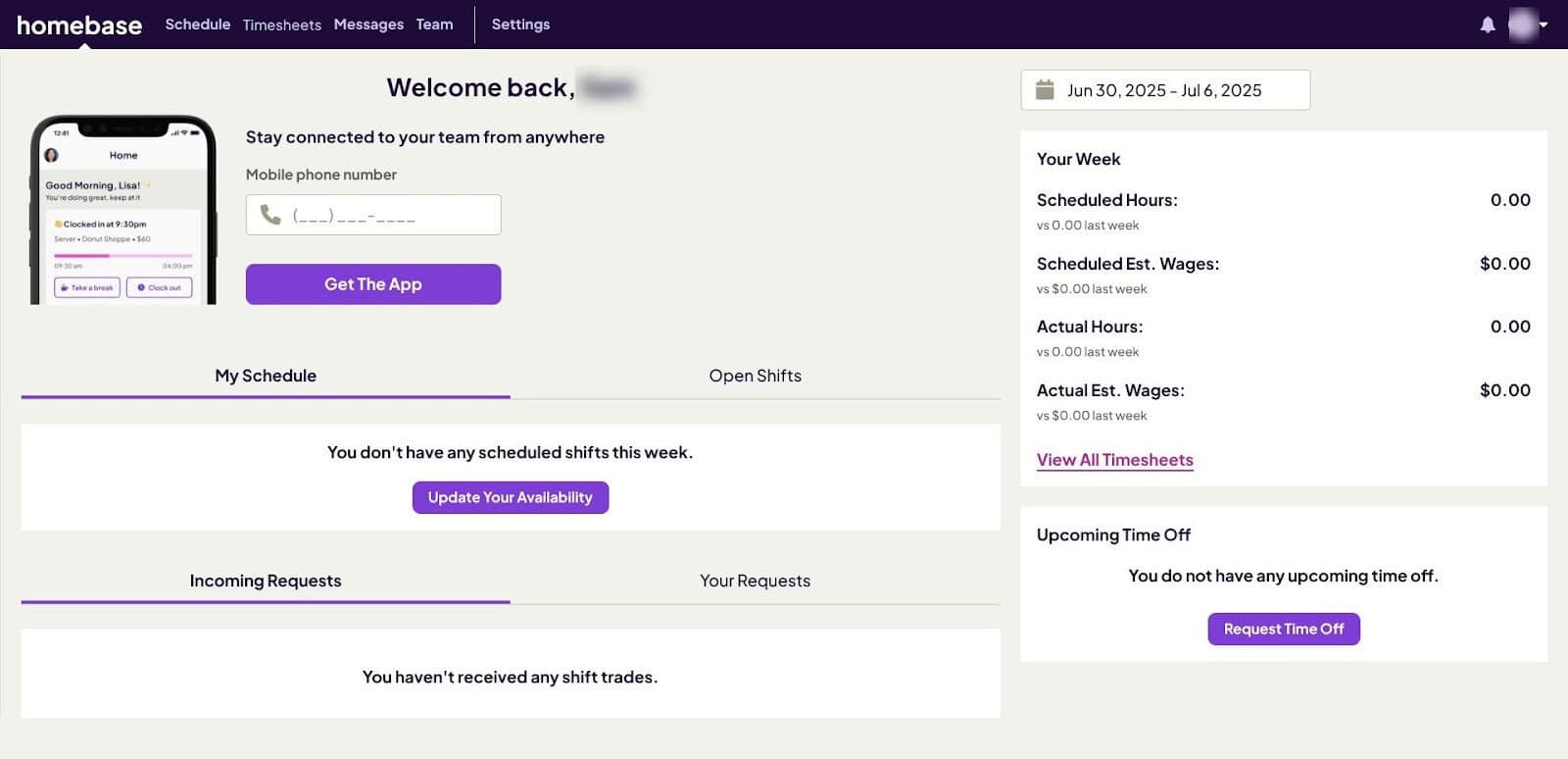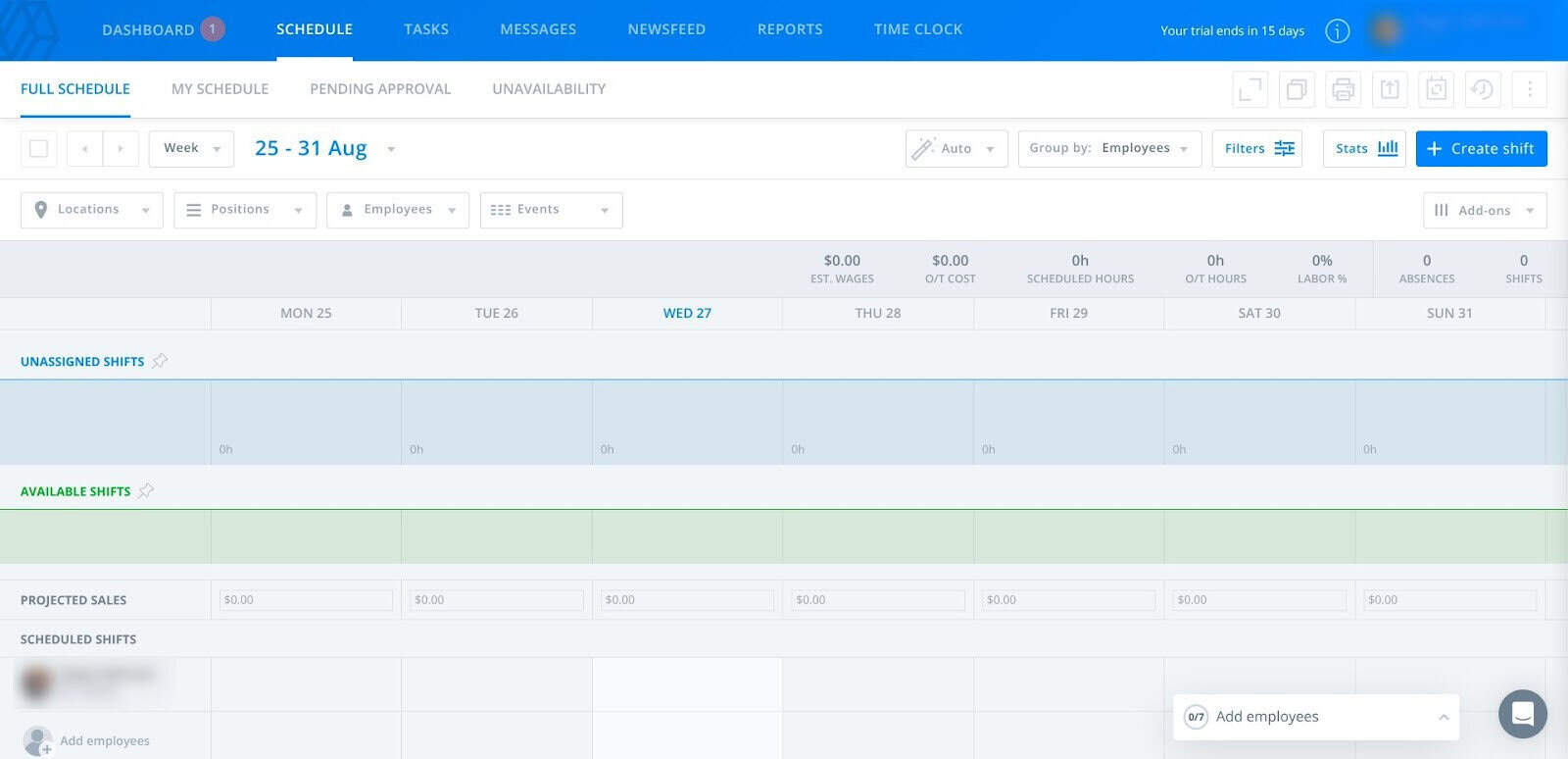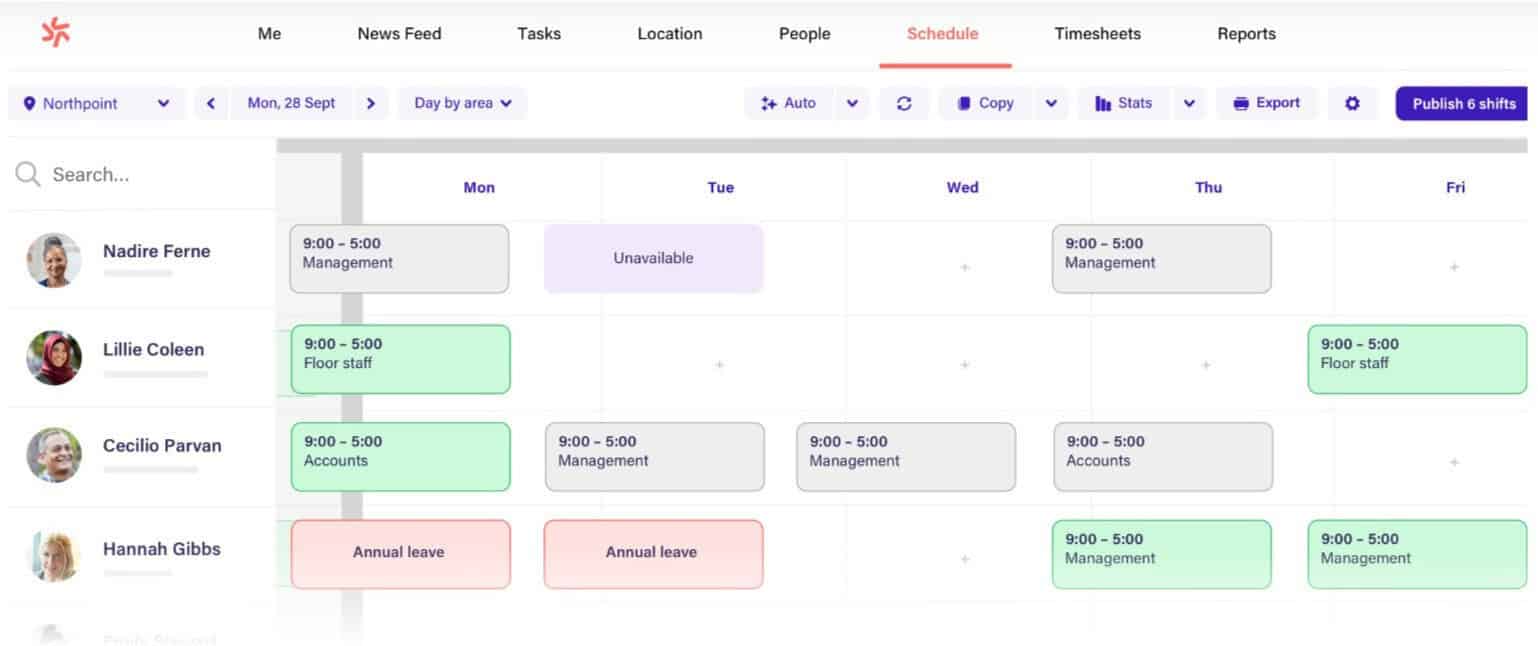- At a Glance: The Best Online Schedule Makers in 2025
- What Are Online Schedule Makers?
- What to Look for in an Online Schedule Maker
- My Top Picks for the Best Online Schedule Maker
- 1. Homebase
- 2. Sling
- 3. Deputy
- 4. Toggl Track
- 5. When I Work
- Use Cases Summary: Who Should Choose Which Platform?
- FAQs about Online Schedule Makers
- My Final Thoughts: Which Online Schedule Maker is the Best?
Last Updated on September 5, 2025 by Ewen Finser
Online schedule makers are an absolute lifesaver.
I run a business with multiple locations, and as we grow, our shift patterns are getting increasingly complicated. My employees are human, of course. And they have human needs. Which means dealing with shift swaps, sick days, and PTO requests.
Without an online schedule maker, I’d be drowning in tasks, forgetting stuff, and not giving out clear schedules to my employees. But these platforms make my life so much easier.
I’ve tested quite a few of them now, and so I’ve made a round-up of the best platforms: from those suited for bigger businesses with multiple locations, through to free tools for managing remote workers. Whatever your business looks like, there’s something here for you.
At a Glance: The Best Online Schedule Makers in 2025
Tool | Best For | Standout Features | Free Trial | Pricing |
Homebase | Managing everything in one platform | ‘Shout out’ feature for employees | No, but free plan available | From $0 p/m, next tier up from $24 p/m per location |
Sling | Easy communication between team members | Can run events and broadcast messages to everyone at once | No, but free plan available | From $0 p/m, next tier up from $1.70 per user per month |
Deputy | Larger businesses with multiple locations | Pay Builder tool helps you to stay compliant and create a fair pay scale | Yes | From $3.50 per user per month |
Toggl Track | Time-tracking for remote workers | Timer allows you to manage remote workers | Yes, and free plan available | From $0 per user per month, with next tier up from $3.25 per user per month |
When I Work | Ease of use on the go | GPS clock-in gives you peace of mind | Yes | From $2.50 per user per month (for one location) |
What Are Online Schedule Makers?
Online schedule makers allow you to run a business effectively.
When I was a teenager, I had a job in a restaurant. I had to clock in and clock out using a paper system, and everybody’s shifts were printed out and stuck up on the wall.
Online schedule makers allow you to create these schedules online. Everyone can view them wherever they are, you can adjust them, swap shifts, and manage PTO all in one place. They also make it easier to deal with payroll.
These are absolutely essential if you have multiple employees, and even more so if you have more than one location. You can work remotely and still keep an eye on things from afar. As a business owner with two locations to keep track of, these tools are invaluable to me.
What to Look for in an Online Schedule Maker
So if you’re looking for an online schedule maker, here are the key things I think you need to look for:
- Ease of use. Look for something with a clean UI, an easy onboarding process, and an easy learning curve. This is vital if you’re super busy and don’t have the time to learn a whole new skillset.
- Features. Features you’ll need include: schedule making and management, timesheets, clock-in/clock-out tools, employee management, and team communication tools (like messaging apps).
- Pricing. Pricing usually works per-person, per-month. And you may have to pay more for premium features and for multiple locations. Free trials are always good, because you can test things out before you commit.
- Employee well-being features. This can include PTO requests and opportunities to praise employees/have them highlight each other’s performance.
- Time tracking. For remote workers, having an in-built time tracker on the platform is really helpful.
The key is to find something that gives you a lot of tools in one place, so you don’t have to sign up to loads of different platforms to manage everything. But you also need to consider ease of use, too.
My Top Picks for the Best Online Schedule Maker
Here are the five online schedule makers I’ve tried. I’ve included an overview of features, how I personally felt about them, and some details on pricing.
1. Homebase
Best for managing everything in one platform

Homebase packs a lot of features under one roof, and I like that it has an emphasis on employee wellbeing. I can schedule shifts, approve or deny shift swaps and PTO requests, send messages to everyone so we’re all on the same page, and analyze hours worked/manage timesheets for payroll purposes.
Designed for all kinds of businesses, I find it invaluable in terms of managing multiple locations and complicated shift patterns. Having it all under one roof is a lifesaver, and I think it’s already making a big difference to my workflow.
Onboarding is straightforward from both my perspective and my employees, and once they’re on, I can easily contact them if I need to. Which cuts down on the number of platforms I have to use to communicate.
I also want to shout out the UI of Homebase, which is super easy to use. It’s clean, it’s easy to navigate, and I like being able to see urgent requests right away when I log in, so I can manage the most important tasks first. It makes everything feel a little more effortless, which, when I’m super busy, is a key highlight for me.
Key Features
- Easy, clean UI and clear dashboard with requests easy to see
- Simple to set up shift patterns and timesheets
- Good mobile app to keep everyone connected
- ‘Shout out’ feature enables employees to give each other praise and feedback
Pricing Snapshot: Limited free plan; next plan up from $24 p/m per location
2. Sling
Best for: Easy communication between team members

Sling is great for scheduling. When I tried it, I found it fairly easy to set up my employees, and then I could easily schedule shifts, swap them around, and manage several locations while also having different levels for employees.
A standout feature is the Events tool. This allows me to set up events that involve particular team members (or everyone all at once). So if we’re running a special day, I can quickly rope everyone in at once.
Plus, I can broadcast messages to everyone. So if we’ve got a new promotion, I can send the info to everyone at once. I can also set up policies and guidance and have them stored on the system as docs, which means everyone can access the information they need. Communication is good using Sling.
Sling allows me to track hours worked and export this info, which makes running payroll pretty straightforward, too.
The downside is that the UI is kind of dated and cluttered, and when you’re using a platform for hours at a time, that can get old pretty quickly. You might find that the pricing is worth it, though, and I do think the lowest-paid tier is very reasonable if you’re a smaller business with just a handful of employees.
Key Features
- Messaging, event creation, and document sharing for easy communication
- Timesheets and time tracking
- Shift creation, shift swaps, and PTO management
- Can manage several locations at once
Pricing snapshot: Limited free plan, with the next tier up starting at $1.70 per month per user
3. Deputy
Best for: Larger businesses with multiple locations

Deputy is, I’d say, best for brick-and-mortar businesses. If you hire a lot of people and you need to manage them, and you have contractors coming in and out, it’s a good choice. You can manage multiple schedules, track hours worked, and use their clock-in/clock-out tools to make sure everyone is paid for work completed.
I like that this feature requires face recognition; it adds another layer of security so that people can’t do anything untrustworthy. And when you work from afar and you don’t get to check in on all your locations as often as you’d like, this is vital.
Deputy can also handle shift swapping, sick days, and PTO requests. So payroll becomes a lot easier.
The pay builder tool is good, too. It helps you to stay compliant, and you can create a pay scale that makes it easier for employees to work their way up and have something to aim for. This is useful for onboarding purposes, as everyone is on the same page from the get-go.
There are also good communication tools. You can chat to employees in a group or one-to-one, and you can manage all communications without having to set up another platform or use emails to do it.
The downside to Deputy is that the learning curve is larger. But once you get going and you have team members set up, you’ll be good to go.
Key Features
- Manage multiple locations
- Shift creation, scheduling, shift swapping, PTO, and sick day requests
- Clock-in and clock-out tools requiring facial recognition
- Pay builder tool to create a fair pay scale for all
Pricing snapshot: From $3.50 per user per month, or $4.50 per user per month to unlock most of the features
4. Toggl Track
Best for: Time-tracking for remote workers

Toggl Track is a minimalist, easy-to-use time tracking tool for teams. I think this works better for online-based teams involving remote workers. So if you run a business and you have people scattered across the world, this one is worth checking out.
You can set up projects, assign employees to specific tasks, and have a catalog of client info for everyone to get hold of. There are a lot of features you will enjoy using if you run a team remotely; communication between team members is really clear, and you can quickly see who is supposed to be doing what to finish your next project on time.
The best tool is probably the timer. It allows all users to ‘clock in’ virtually, so that you can accurately see how many hours are going to which specific tasks. This is useful for payroll purposes, but it also means you can get an accurate view of how long tasks take, which makes future planning easier.
I also like the Tags system, which allows you to set up tags for specific things. This is really useful for finding tasks quickly, but also lets you track tasks that might not align to a specific project (like admin tasks, for example).
The features, combined with the modern UI, make Toggl an appealing choice for me. It doesn’t quite work for what I need, as I have brick-and-mortar businesses, but I absolutely see why people would enjoy using it.
Key Features
- Timer feature allows you to see how long tasks are taking to complete, and makes it easier for payroll purposes
- Tags for quickly finding/organizing tasks
- Projects are easy to set up with employees assigned to specific jobs
- Client roster allows everyone to quickly see vital info
Pricing snapshot: Limited free plan available with basic features, with Premium plan coming in at $3.25 per user per month
5. When I Work
Best for: Ease of use on the go

When I Work is a useful tool for all kinds of businesses. It works for me with multiple locations, but it’s designed to work for all sectors. During the setup process, you can choose from a huge range of businesses, and it tailors the features to suit your needs.
I would say that When I Work would be really useful for both me and my employees. They can clock in using their phone, and I can be reassured that they’re in the right place using GPS clock-in. It’s a small security tool, but it’s good for peace of mind when you can’t physically visit all of your locations.
You can use the scheduler to set up shift patterns, which can be repeated, and you can manage shift swaps, PTO requests, and sick days. Which makes payroll easier. The ‘attendance’ tool allows you to quickly monitor employees’ attendance, which is useful.
The ‘workchat’ feature keeps you connected. But this does launch in a separate app. Still, you can chat to employees whenever you like, which is helpful for staying connected to your team.
I would say the UI isn’t my favourite, and the learning curve was a little higher than some of the others I’ve tried.
Key Features
- Mobile app allows employees to chat to you whenever
- GPS clock-in is a good safety feature
- Can handle repeated shift patterns, shift swaps, PTO requests, and sick days
- Easy to track attendance
Pricing snapshot: From $2.50 per user for one location, or $5 per user for multiple locations
Use Cases Summary: Who Should Choose Which Platform?
Here’s a cheat sheet:
- Remote workers – Homebase or Toggl Track
Good time tracking tools that you can use wherever you are in the world.
- Larger businesses – Deputy
Can manage multiple locations and complex shift patterns
- Small businesses or start-ups – Homebase or Sling
Decent pricing for the features you get, good for smaller businesses
- Freelancers – Homebase or Toggl Track
You can still manage contractors and freelancers without having extra features you don’t need
FAQs about Online Schedule Makers
Are there free online schedule makers?
Yes. Homebase, Sling, and Toggl Track all have free plans.
Will online schedule makers help me to stay compliant?
Depending on the platform, yes. Check the features before you sign up to make sure.
Can online schedule makers prevent employee fraud?
Yes. Look for clock-in features (Deputy and When I Work are good for this) that use facial recognition or GPS tracking.
My Final Thoughts: Which Online Schedule Maker is the Best?
Online schedule makers are so good for making life easier as a business owner. I really can’t do without them.
If you manage brick-and-mortar businesses or you’re working remotely, there are options out there (including free ones!) that will make keeping track of payroll so much easier. Peace of mind for me, and for my employees, because they know they’ll be paid accurately for work they’ve completed.

